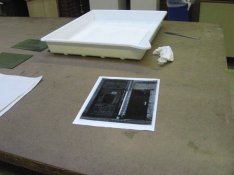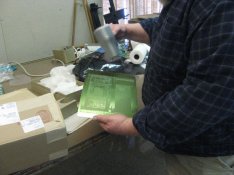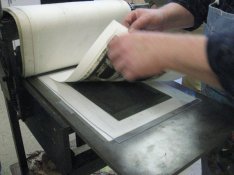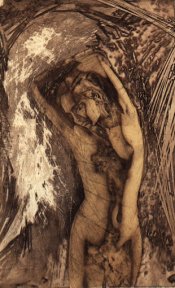Many thanks, Suzanne, for the publicity. Yes, it is poly-gravure, or whatever you choose to call this bastard son of the true gravure process, not the real, copper plate variety. The plates I used yesterday were not Solar Plates (as sold by Dan Weldon and explained
here) but Toyobo KM73 plates available through
Boxcar Press in Syracuse, NY and other establishments in other parts of the world. The KM73 plates are harder and more suitable for fine detail and continuous tone than are the solar plates, though solar plate printing is great for high contrast or drawn and manipulated prints like those that Emil has posted. Each has its own strength.
I don't know about this process being a Danish invention, Emil, I'll have to take your word for that. I do know that the plates all come from Japan. What you say about the mastery needed, however, is quite true. I have been printing intaglio work since the early 1970's and I am still a beginner. The "really good photographer" part will undoubtably elude me for the rest of my life.
I second John Voss's good words about his wife's work, her prints are inspiring - and really what spurs me on in this. If Susan is giving any workshops, John, let me know. There are many others out there, certainly Kari Holopainen is among them. The positive transparency is the tricky part, to be sure. Computer printed images work well, but so have ortho-litho prints that have been developed for continuous tone. The image I printed yesterday used a positive made with Ultrafine ortho-litho film developed in Sprint paper developer. I've even used copy machine transparencies, but you have to want that look. I want to try the continuous tone positive film being sold by Efke, since I used to use it's Kodak cousin, but I haven't gotten to it yet. Too many ideas, too little time. As for the half-tone screen, Pahedrus, I use a computer generated and image setter printed stochastic screen, purchased from
Dan Weldon's website. Without it, you get very high contrast - no mid-tones.
As for the need for a press, I disagree with Emil on this. The pressure needed to really get the mid-tones of a printing plate are considerable. You can print rough textures and the surface inks without much more than the back of a serving spoon rubbed over the paper, but a press is a necessity for a tonally nuanced image. This is why many printmaking courses at local community colleges and art centers are filled with veteran printmakers - access to a press is worth the cost of signing up for yet another course.








 )) from about 1989...
)) from about 1989...





